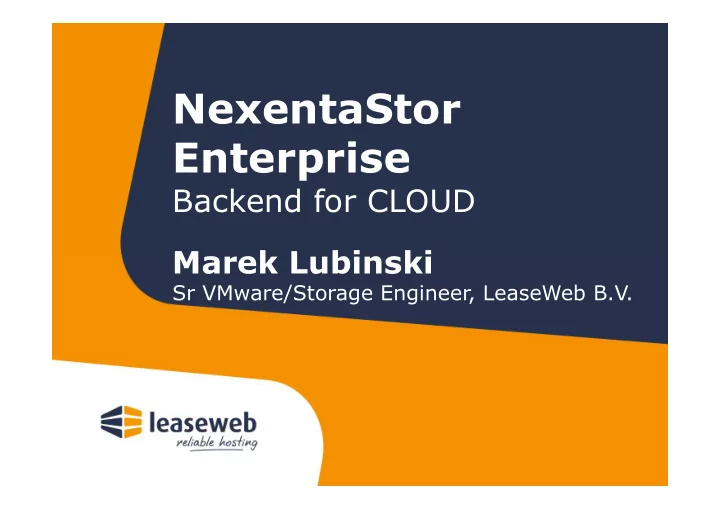

NexentaStor Enterprise Backend for CLOUD Marek Lubinski Marek Lubinski Sr VMware/Storage Engineer, LeaseWeb B.V.
AGENDA LeaseWeb overview • Express Cloud platform • Initial storage build • Why NexentaStor • NexentaStor initial design/sizing • Base migration and challenges • What went wrong • Sizing review, changes • Final configuration, what next Final configuration, what next • • Lessons learned •
About LeaseWeb Founded in 1997 • Part of the OCOM group • DataXenter (Modular Data Center • Technology) EvoSwitch (Carrier-neutral Data Center • Services) Fiberring (Network Services) • LeaseWeb (Hosting Provider) • Cloud, Dedicated Servers, Colocation, Hybrid Cloud, Dedicated Servers, Colocation, Hybrid • • Infrastructure >50.000 physical servers in 6 data centers • >3,0 Tbps bandwidth capacity • IaaS Cloud services: Private/Hybrid Cloud, • Premium Cloud, Express Cloud
Express Cloud platform Old situation: • VMware vSphere 4.x clusters • Mixed hardware vendors • Storage: Supermicro & Dell R510 (Linux NFS) • New situation: • Cloudstack backend with KVM hypervisors • Standard hardware: Dell, HP • Storage: NexentaStor Enterprise (NFS) •
Initial storage build Supermicro: 24x SATA in RAID10, 1Gbit, • Linux NFS Design challenges: • Performance issues (50-200 VM's per box) • SPOFs • rack space • Scalability • Flexibility • Expensive growth Expensive growth • • Lack of performance indicators. • Thousands of VMs running •
Why NexentaStor ZFS • Resiliency • Scalability • Performance • Snapshots • Compression • Native NFS (also CIFS+iSCSI support) • Dtrace • HA cluster (Active/Passive or Active/Active) HA cluster (Active/Passive or Active/Active) • • no HW vendor lock-in (heads, JBODs, • components, disks)
NexentaStor initial design/sizing Estimations: • Platform IOPs -> max. 40k IOPs per setup • Avg IO size: 4-8k • Read/write ratio: 70/30 • Cache/hit ratio (when compared to a different • platform with PAM2): 30% Design/configuration: • HA cluster (Active/Passive) • RAIDZ-2 (11vdevs, 6disk/vdev) RAIDZ-2 (11vdevs, 6disk/vdev) • NL-SAS drives +2x ZeusRAM SSD 8GB (ZIL) + 4x • OCZ SSD (L2ARC), 3x JBOD Supermicro head: 2 CPUs QC + 96GB RAM, LSI SAS • HBA’s, 10Gbit Intel NICs One rack • Network backend: EX4200 Juniper switches + Cisco • 3750X, 10Gbit to storage
Base migration and challenges Start of Cloudstack POD setup on Nexenta storage • Migration of vSphere workloads: • Scripted storage VMotion • Problems with storage VMotion after ~1200 VM’s • migrated (NFS kernel tweaks) Performance: • Iometer benchmark • Rapid growth causing performance issues: • Iometer low results • Increased latency to 100msec • Maxing ZIL throughput • Tracing storage abusers: • Swapping --------------> •
What went wrong Bigger average IO size • 8-32k • It maxed estimated 40K IOPs • Different read/write ratio • Read/write: 20/80 • 90% random • NFS sessions default limit • After 1200 VM's running storage vMotion started to • fail fail No new disk IO operations were possible (copy, etc.) • Current workloads were not affected • NFS timeout settings recommendations • esxcfg-advcfg -s 24 /NFS/HeartbeatFrequency • esxcfg-advcfg -s 10 /NFS/HeartbeatTimeout • Large growth of CS VMs caused high peaks in NFS • Ops resulting in increased latency to data stores
Sizing review, changes, data migration New VM Pool • Only mirrored VDEVs using only SAS15k drives • More ZeusRAM disks (ZIL) • More OCZ SSD disks (L2ARC) • More memory (192G) - ARC • Bigger heads (more LSI SAS cards) • Iometer benchmark • 100% random • 70% read 70% read • Old data migration (scripted VMware storage • vMotion) Cloudstack migration plan (ZFS sync + NFS • remount)
Final configuration and next steps Desired configuration • 2x VM Pool on SAS15k • Multiple ZeusRAM (ZIL) • Multiple OCZ SSD (L2ARC) • In case of performance issues option to go • active/active setup Very scalable with decent performance • Future steps: Future steps: • • Exact build for other locations (Frankfurt, U.S.) • Off-site replication for data protection •
Lessons learned Use only mirrored VDEVs with high • expectations Achieved cache/hit ratio: 90% • Use Dtrace to find storage anomalies (abusers) • Avoid workarounds (they become permanent) • Play around with the system in test • environments “Nexenta architect training” highly “Nexenta architect training” highly • • recommended
THANK YOU
Recommend
More recommend